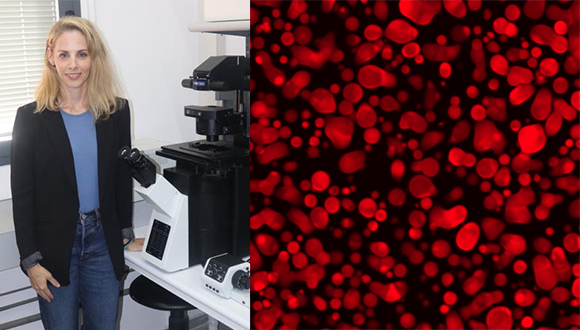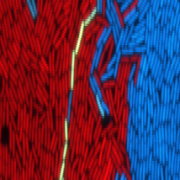Designing Smart Liquids
Dr. Ayala Lampel is developing microscopic droplets of liquid that have the unique ability to respond to specific conditions in the environment. Her latest study was the first to demonstrate how to design a smart liquid that can serve as a sensitive biosensor.
If you are interested in groundbreaking developments and technologies, you’ve probably heard of the term smart materials - materials that "sense" their environment. These materials are designed to have at least one property capable of significantly changing in a controlled way as a result of external stimuli. Dr. Ayala Lampel is one of the few researchers in the world working to bring this smart material revolution to the next stage: instead of smart solid materials, she and her colleagues are developing smart liquids, liquids that are purposely designed to react to their environment in specific ways.
Like droplets of balsamic vinegar floating in olive oil, the researchers at Lampel’s lab at the Tel Aviv University Shmunis School of Biomedicine and Cancer Research are working with liquids that remain separated from each other and form these distinct droplets, or condensates, as a result of their chemical properties. The specific design and composition of the molecules inside these condensates is what gives the liquids their smart properties.
In the latest breakthrough in the field, a study published by Lampel and her colleagues two weeks after the war in Israel erupted, they were able to show for the first time how they can design these condensates to serve as optical sensors: that they change their color and fluorescence intensity in response to the presence and activity of a specific enzyme. The paper appeared in the October issue of the Proceedings of the National Academy of Sciences (PNAS) journal.
Bio-inspired study
Even though her lab is working solely with synthetic materials, without any living organisms involved in the research, the study in Lampel’s lab is bio-inspired: it is based on processes happening in nature, and specifically in her case, inside living cells. "Our cells contain multiple compartments, or organelles, used for different purposes, such as mini-factories for the production of molecules the cell needs. Some of these organelles are separated from the rest of the cell by membranes, but others are created by a process called 'liquid-liquid phase separation' - which relies on multiple weak interactions between the molecules inside the organelle that collectively results in separation from the rest of the environment and formation of condensate with distinct microenvironment," Dr. Lampel explains.
In cells, these condensates are made up of a mixture of proteins and nucleic acids, the cell's genetic material. "Long proteins, composed of hundreds of amino acids, are challenging to work with. So, in the lab, we use peptides - 'mini-proteins' made from short amino acid chains - instead of whole proteins. Because of their short length, the peptides are completely disordered, and lack stable structures and their flexibility is what promotes them to interact and undergo phase separation with nucleic acids into condensates".
By studying the sequences of amino acids in proteins in naturally-occurring condensates, Lampel and other researchers in the field have identified sequences that are involved in the formation of various cellular condensates. "This allows us to use the different sequences like Lego blocks in designing our peptides to control the specific functions we want them to have," she says.
Designing condensates to serve as liquid biosensors
In previous research, Lampel showed how she can design the condensates to release the molecules they contain in response to light - a development that can be used for a controlled release of medications in the body or other functions. In her most recent research, she explored a different approach.
"We wanted to see if we can design condensates that will serve as sensors. Melanin, the pigment that determines our skin color, is produced by an enzyme called tyrosinase which oxidizes a certain amino acid called tyrosine. Elevated levels of this enzyme are involved in several dermal disorders including hyperpigmentation and melanoma. So we designed the peptide that forms the condensate to contain tyrosine. This way, when we added the enzyme to the condensates, it oxidized the peptides within the condensates and changed their optical properties - turning them fluorescent. This study demonstrated the ability to design condensates to serve as liquid biosensors". This work was led by M.Sc. student Amit Netzer with the help other lab members, including Itai Katzir and Dr. Avigail Baruch Leshem, and in collaboration with Dr. Michal Weitman from Bar Ilan University.
Today, Lampel and her colleagues are working on giving the condensates many other new properties. She emphasizes that her interest is also focused on basic science - on discovering and expanding the uses and capabilities of the smart materials.
For example, in addition to advanced and sensitive biosensors, the ability to accurately control the phase separation can also be used to design smart liquids for the effective production of therapeutic biomolecules that today requires costly and complicated conditions to produce. Lampel also envisions how the condensates could be used as vessels to deliver medication into the body and even to serve as "mini-factories" producing medications inside us, and they can be designed to react to specific environments and this way control where exactly this production is happening.
"This is a brand new field. It still doesn’t know what it is, and what it is good for, but it is expanding rapidly, with many new papers and patents published every month," Lampel summarizes.
Read full article - "Emergent properties of melanin-inspired peptide/RNA condensates" >>





